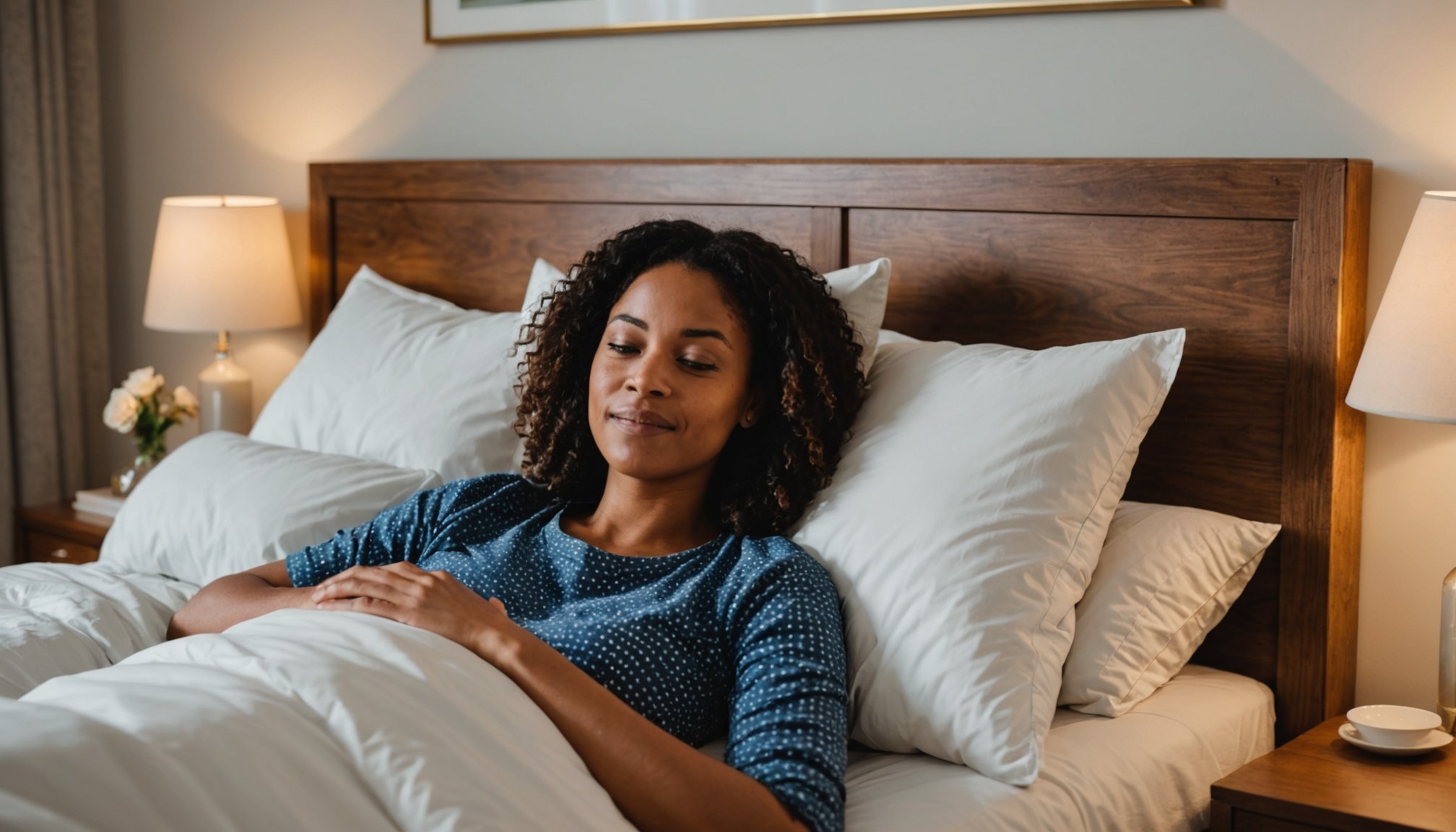Ultimate Guide for UK Residents: Transform Your Sleep Space for Improved Rest and Relaxation
Understanding the Importance of Sleep
Sleep is a cornerstone of our overall health and well-being, yet many of us struggle to get the quality sleep we need. According to Dr. Nilong Vyas, managing director at paediatric sleep consultancy Sleepless in NOLA, “Seven to eight hours of sleep a night has been proven to be the magic number of hours for adults, with babies, children and teenagers needing more”[4].
Sleep affects not only our physical health but also our mental health and daily productivity. Lack of sleep can lead to increased stress, poor mood, and reduced cognitive function. Therefore, creating a sleep-conducive environment is crucial for improving your sleep quality.
In parallel : Unlocking Flexibility: How Consistent Pilates Can Benefit Seniors in the UK
Designing Your Sleep Space
Choosing the Right Bed and Mattress
The bed is the centerpiece of your sleep space, and selecting the right one can make a significant difference in your sleep quality. Carl Walsh, the resident sleep specialist and owner of Bed Guru, emphasizes the importance of handpicking every bed and mattress sold by his company. “If we wouldn’t own it, we don’t sell it. It’s that simple,” he says[1].
Here are some key factors to consider when choosing your bed and mattress:
In parallel : Unlocking Wellness: The Surprising Advantages of Pilates for Women in Their 30s Across the UK
- Comfort: Ensure the mattress is comfortable for your body type and preferred sleeping position. For example, back sleepers might prefer medium-firm mattresses, while side sleepers often need softer options[5].
- Support: The mattress should provide adequate support for your spine and neck.
- Materials: Consider the materials used in the mattress, such as memory foam, latex, or traditional coil springs.
- Size: Choose a bed size that fits your room and personal needs.
Bedding Essentials
Beyond the bed itself, the right bedding can significantly enhance your sleep experience. Here are some essential items to consider:
- High-Quality Sheets: Soft, breathable sheets can make a big difference in comfort. Look for materials like cotton, linen, or bamboo[5].
- Thread Count: Higher thread counts often indicate softer and more durable sheets.
- Material: Choose materials that suit your climate and personal preferences.
- Supportive and Comfortable Pillows: Pillows play a crucial role in supporting your neck and spine. Select pillows based on your sleeping position[5].
- Back Sleepers: Medium-firm pillows
- Side Sleepers: Thicker, firmer pillows
- Stomach Sleepers: Thin, soft pillows
- Blankets and Quilts: Add layers for warmth and texture. Consider seasonal quilts or coverlets for versatility[5].
- Weighted Blankets: Known for providing a sense of calm and improving relaxation.
- Bedside Rug: A soft bedside rug can add warmth and comfort to your room[5].
Creating a Sleep-Conducive Environment
Lighting and Temperature
The environment in your bedroom can greatly impact your ability to fall asleep and stay asleep. Here are some tips to create a sleep-friendly environment:
- Lighting:
- Use blackout curtains or blinds to block out external light.
- Avoid bright lights in the bedroom, especially in the hour leading up to bedtime[4].
- Temperature:
- Maintain a cool temperature in the bedroom. A cooler room can promote better sleep.
- Use temperature control devices, such as thermostats or smart heating systems, to keep your room at an optimal temperature.
Noise and Distractions
Noise and distractions can significantly disrupt your sleep. Here are some strategies to minimize them:
- Noise Reduction:
- Use earplugs or white noise machines to block out external noise.
- Consider soundproofing your bedroom if possible.
- Electronic Devices:
- Avoid using electronic devices at least an hour before bedtime. The blue light emitted by these devices can interfere with your sleep hygiene[4].
- Use blue light filtering glasses or apps that reduce screen brightness.
Sleep Hygiene Practices
Good sleep hygiene practices are essential for improving your sleep quality. Here are some tips to help you establish a healthy sleep routine:
Establish a Bedtime Routine
- Develop a consistent bedtime routine that signals to your brain that it is time to sleep. This could include activities like reading, taking a warm bath, or practicing gentle stretches.
- Stick to your routine even on weekends to maintain a consistent sleep schedule.
Limit Stimulants and Alcohol
- Avoid consuming stimulants like caffeine and nicotine close to bedtime. These substances can make it difficult to fall asleep and reduce the quality of your sleep[4].
- Limit alcohol consumption, especially in the hours leading up to bedtime. Alcohol can disrupt your sleep patterns and reduce the quality of your sleep.
Create a Relaxing Atmosphere
- Use calming scents like lavender to create a relaxing atmosphere in your bedroom.
- Ensure your bedroom is quiet, dark, and cool to promote better sleep.
Practical Tips for Improving Your Sleep Space
Here are some practical tips to help you transform your sleep space:
Invest in Quality Bedding
| Item | Description | Benefits |
|---|---|---|
| High-Quality Sheets | Soft, breathable materials like cotton, linen, or bamboo | Enhances comfort, durability, and overall sleep experience |
| Supportive Pillows | Pillows tailored to your sleeping position | Provides necessary support for your neck and spine |
| Blankets and Quilts | Versatile layers for warmth and texture | Adds warmth, texture, and style to your bed |
| Weighted Blankets | Provides a sense of calm and gentle pressure | Enhances relaxation and improves sleep quality |
| Bedside Rug | Soft rug beside your bed for warmth and comfort | Adds warmth, comfort, and style to your room |
Optimize Your Bedroom Layout
- Minimize Clutter: Keep your bedroom clutter-free to reduce stress and promote relaxation.
- Use Calming Colors: Choose calming colors for your bedroom walls, such as blues, greens, or neutral tones.
- Add Plants: Incorporate plants that promote relaxation and improve air quality, like lavender or peace lilies.
Utilize Technology Wisely
- Smart Lighting: Use smart lighting systems that can adjust brightness and color based on the time of day.
- White Noise Machines: Utilize white noise machines or apps to block out external noise.
- Sleep Tracking Devices: Use sleep tracking devices or apps to monitor your sleep patterns and identify areas for improvement.
Real-Life Examples and Success Stories
The Bed Guru Experience
Carl Walsh of Bed Guru has spent 40 years curating beds and mattresses to ensure his customers get the best possible sleep. His philosophy is simple: “Everybody deserves a great night’s sleep.” By handpicking every product and offering free nationwide delivery, Bed Guru has become a trusted name in the industry[1].
CitizenM Hotels
CitizenM hotels are known for their focus on providing a great night’s sleep. With features like blackout curtains, temperature control via iPad, and gigantic, comfortable beds, these hotels have mastered the art of creating a sleep-conducive environment. As one reviewer noted, “We usually don’t sleep well in hotels because of light, noise, and weird beds, but we sleep like babies with CitizenM”[2].
Transforming your sleep space is a journey that requires attention to detail and a commitment to creating a sleep-friendly environment. By choosing the right bed and mattress, investing in quality bedding, and optimizing your bedroom layout, you can significantly improve your sleep quality.
Remember, good sleep is not just about the number of hours you sleep but also about the quality of those hours. By following the tips outlined in this guide, you can make your bedroom a sanctuary for rest and relaxation, helping you feel better rested, more productive, and healthier overall.
As Carl Walsh of Bed Guru puts it, “We won’t rest until you do.” So, take the first step today and start transforming your sleep space into a haven that promotes better sleep, relaxation, and overall well-being.











